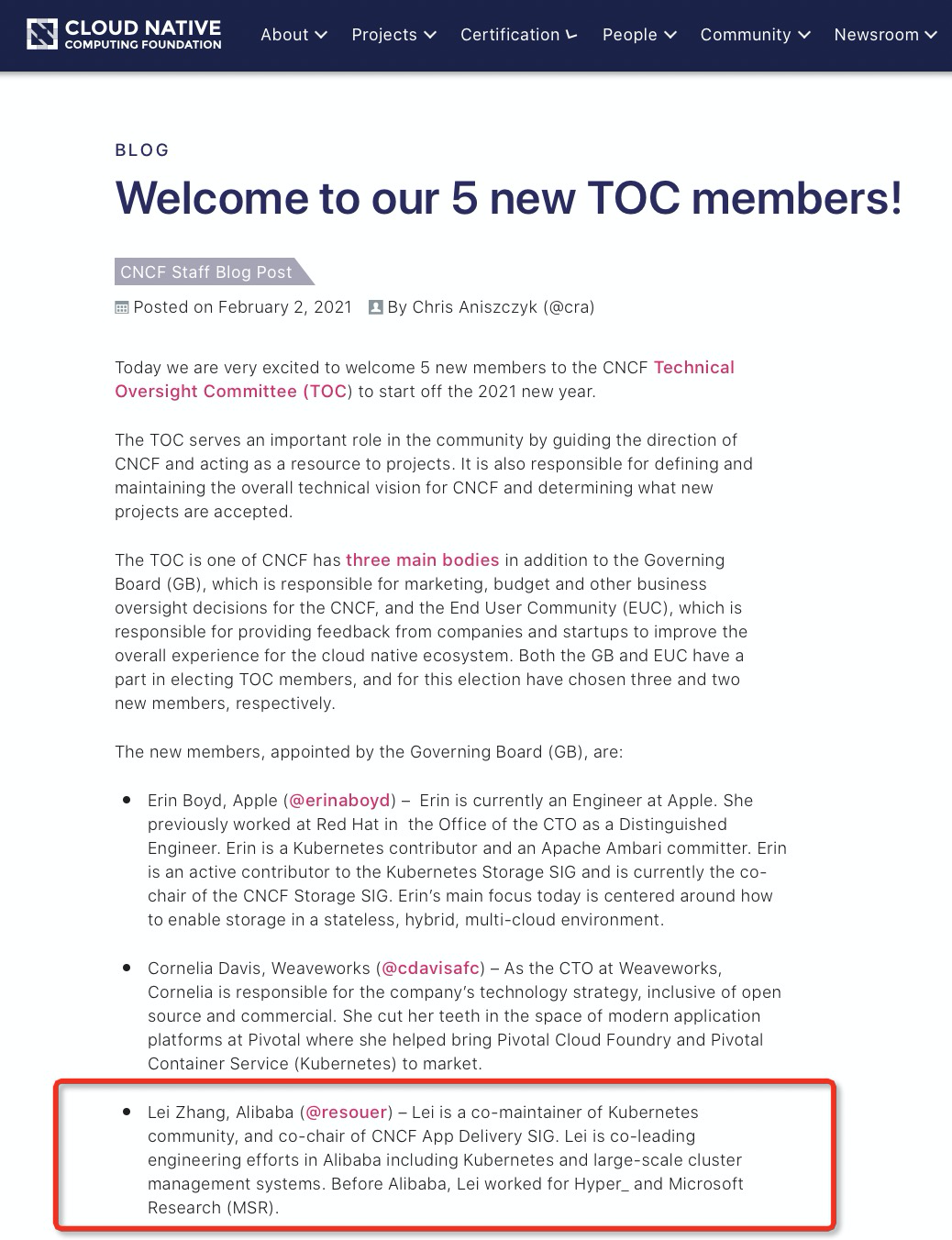On February 2, 2021, the Cloud Native Computing Foundation (CNCF), the world's top open-source community, officially announced its new term of Technical Oversight Committee (TOC). Zhang Lei, a Senior Technical Expert of Alibaba Cloud, was elected as the only representative from a Chinese enterprise among the current nine TOC members.

CNCF explained in its official announcement that Zhang Lei was elected because of his outstanding contributions to Kubernetes. "Zhang Lei is a Co-Maintainer of the Kubernetes community and a Co-Chair of CNCF App Delivery SIG. He is in charge of the Kubernetes and large cluster management systems at Alibaba."
Founded in July 2015, CNCF is an affiliate of the Linux Foundation. CNCF devotes itself to maintaining and integrating open-source technologies while focusing on cloud-native to serve cloud computing. It also supports application orchestration based on the containerized microservice architecture. Currently, CNCF has more than 300 member companies, including AWS, Azure, Google, Alibaba Cloud, and other mainstream global cloud computing vendors. CNCF TOC is composed of nine representatives with rich technical knowledge and industry background. Those representatives provide technical support and guidance for the cloud-native community.
Since 2017, Alibaba has invested a lot in cloud-native technologies and participated in the development and maintenance of many top-level open-source projects, such as ETCD, Kubernetes, and ContainerD. It has also completed the self-upgrade of the overall infrastructure through the cloud-native technology stack. Some star projects, such as the exclusive open-source Dubbo and RocketMQ, are donated to the Apache Foundation and graduated as top projects. Since the release of open-source Spring Cloud Alibaba, it has become the most active Spring Cloud implementation of Spring Cloud with the best development experience. Dragonfly has become a CNCF incubation project, and OpenYurt and OpenKruise have entered the CNCF Sandbox. What's more, Alibaba has released the world's first Open Application Model (OAM) with Microsoft Azure to lead the cloud-native standard application delivery ecosystem. After the release of OAM, Alibaba launched KubeVela, a core engine of the cloud-native platform based on OAM. KubeVela is the implementation of the Kubernetes ecosystem in constructing standard application delivery systems. Together with Nanjing University, Alibaba has opened Fluid, a cloud-native infrastructure project. Fluid is an important component for big data and AI to embrace the cloud-native. In addition, Alibaba Serverless Devs has become the first Serverless Tool from China among CNCF Landscape Tools.
By the end of 2020, over ten Alibaba projects entered the CNCF Landscape, which ranks among the top ten in the world in terms of the number of projects in the Kubernetes community.
Currently, Zhang Lei is the only member of CNCF TOC from a Chinese enterprise. Born in 1989, he is one of the youngest early maintainers of the Kubernetes community. He initiated and participated in the design of multiple Kubernetes features, such as Container Runtime Interface (CRI), equivalent class scheduling, and topology resource management. With his continuous influence in the Kubernetes community, Zhang Lei was elected as the CNCF official ambassador in 2016 and served as the KubeCon reviewer and Keynote Speaker for several consecutive years. In 2019, Zhang Lei was elected as the Co-Chair of the CNCF Application Delivery Team. So far, he is the only Chinese Co-Chair among the seven CNCF teams.

Zhang Lei, Senior Technical Expert of Alibaba Cloud Container Platform
At Alibaba, Zhang Lei has participated in the design of the cloud-native application infrastructure of Alibaba Cloud and the maintenance of the largest public cloud container cluster in China. His "application-centered" standard application delivery system gives birth to a series of prospective and leading open-source technologies for cloud-native application management.
Zhang Lei and his team jointly developed OAM with CTO Office of Microsoft Azure. OAM is the first standard model and framework for cloud-native application delivery and management in the industry. It has quickly become the model for several enterprises worldwide to build their cloud-native application platforms, such as MasterCard and 4Paradigm. It has also become a standard project of the China Academy of Information and Communications Technology (CAICT) and the Ministry of Industry and Information Technology (MIIT) called "General Requirements and Reference Framework for Cloud Computing Open Architecture ." OAM has been listed as one of the "Top Cloud-Native Technology Trends of 2020" by TheNewStack and "Top 10 New Open-Source Projects in 2020" by InfoQ.
Today, no one will question the rationality of a platform team's adoption of Kubernetes as its infrastructure. In 2020, Kubernetes projects have almost achieved the final goal. They aim to bring platform-layer abstractions to the cloud computing infrastructure, which allows the platform team to construct "everything" based on these abstractions.
However, what is "cloud-native" exactly? Why is it so attractive to the cloud computing ecosystem? What is the future of cloud-native in China? Let's learn about the opinions of Zhang Lei through a Q&A session:

Q: Congratulations! You are now one of the nine CNCF TOC members! Let's have a brief self-introduction first, shall we?
Zhang Lei: Currently, I am responsible for technical work related to the infrastructure of the cloud-native application platform at Alibaba Cloud. I am also involved in promoting the construction of Alibaba's core open-source projects, such as OAM/KubeVela, OpenKruise, and OpenYurt. Before working for Alibaba Cloud, I mainly worked for the upstream part of the Kubernetes community. I was one of the early initiators and maintainers of multiple core features, such as CRI and scheduler. I was also a member of the KataContainers project team. Recently, my team and I have worked with CNCF TOC and over 40 companies to promote the establishment of a vendor-neutral working group for GitOps application delivery.
Q: What is your opinion about the development and evolution of cloud-native in recent years?
Zhang Lei: Cloud-native technologies are becoming more popular. We can see that this new way of application delivery is combining with key technologies, such as the standard application model and Mesh-based progressive release. The combination has become the mainstream method of building application platforms in the industry.
The well-known cloud-native is a set of best practices and methodologies for using cloud computing technologies to reduce costs and improve user efficiency. Therefore, the cloud-native has innovated and evolved since its birth.
Whether it is the great success of container technologies represented by Docker in 2014, or the rapid rise of container orchestration technologies represented by Kubernetes in 2019, or the almost "all-encompassing" ubiquity of cloud native today, the concept of cloud native is continually evolving from theory to practice, and has successfully helped us develop new ideas and architectures. The continuous evolution of cloud-native is based on its core idea, which gradually affects all aspects of the cloud computing field. This is a main development trend of the cloud-native ecosystem in recent years.
Q: What do you think were the major changes in the cloud-native field last year? What influences will they bring?
Zhang Lei: In 2020, we can see that the rapid popularization of cloud-native is bringing changes based on the cloud to more fields. These fields can be integrated into the capability pool of cloud computing through the cloud-native system, which reduces costs and improves efficiency for end users. Let's use the CNCF open-source community as an example. In 2020, OpenYurt and OpenKruise from Alibaba entered the CNCF Sandbox. Virtual Cluster from Alibaba became an official sub-project of Kubernetes, and many core projects, such as OAM/KubeVela were incubated. The emergence and popularization of these open-source technologies promote the continuous development and evolution of the cloud-native ecosystem. They are also making it a reality to provide the benefits of cloud computing.
In 2020, cloud-native remained the fastest-growing element in the entire cloud computing ecosystem. With this growth momentum, it is already time to think about the future developments of cloud-native. Many cloud vendors and teams are actively investing in and exploring the future cloud-native technologies in different fields.
Q: What do you think cloud-native will become in the future?
Zhang Lei: Today, cloud-native is getting closer to the idea that "software is naturally born and grows on the cloud." However, the development of cloud-native has also revealed many problems. For example, the original cloud-native technology focused too much on infrastructure abstraction and management while neglecting the end-user experience. Fortunately, the changes in the cloud-native field in 2020 have shown that the cloud-native community is gradually moving closer to end users by submerging capabilities and producing value. This explains the influence brought by many cloud-native technologies after Kubernetes. For example, Service Mesh is rapidly changing middleware and microservice governance technologies. GitOps is having a critical influence on the continuous delivery field. OAM and Dapr are solving the problems of application abstraction models and service access models.
Over the next few years, we expect the inherent agility and user stickiness of cloud-native technologies will be applied further. Cloud-native will witness further application in more vertical fields, such as database, AI, and edge, together with the huge capability pool of cloud computing. Thus, cloud-native will widely change the underlying infrastructure of cloud computing and the deployment and distribution of cloud applications. It may directly reflect the "ubiquity of cloud computing" in the future.
Q: What areas will you focus on after being a TOC member?
Zhang Lei: In the future, I will work with CNCF TOC to continuously focus on upper-layer technology fields that can bring direct value to end users, such as application management and delivery, cloud-native programming models, and cloud developer experience. Together with the community, I will help better incubate and introduce potential open-source projects in these fields to CNCF. At the same time, TOC will make long-term plans, especially on key underlying technologies, such as WebAssembly and eBPF, which have recently risen rapidly. Don't be surprised if Kubernetes is no longer the best-known project in CNCF in the near future.
Q: Do you have any ideas or suggestions on how to promote the development of the cloud-native ecosystem in China?
Zhang Lei: Many people think that the best and most robust cloud-native community in the world today is in China since Google and AWS do not use Kubernetes. Today, the cloud-native community in China has gathered many professionals, and the cloud-native scenarios and environments are growing rapidly. These are what cloud-native developers around the world dream about. They facilitate the rapid development of the cloud-native ecosystem in China and help release the benefits of cloud-native.
Therefore, as a member of the cloud-native ecosystem from China, we should not follow and be bolder in innovation. At the same time, we should be more confident to introduce our technologies to the world and actively work with some neutral organizations to speak our minds. These organizations, such as CNCF, must have global influence and consider our discourse power. We should actively incorporate users, participants, and contributors from North America and Europe into our community. The full collaboration of various Chinese cloud-native vendors, community members, and open-source project maintainers is required. I think that the nearly-fully-localized KubeCon summit and the cross-company and cross-region Cloud-Native Programming Hackathon will soon bear fruit in the Chinese cloud-native community.
What exactly is cloud-native? Since its emergence, many engineers, teams, and enterprises that have encountered cloud-native have asked this question.
Cloud-native is a set of best practices and methodologies that "uses cloud computing technologies to reduce costs and improve efficiency for users." Cloud-native is in continuous self-evolution and innovation. As Zhang Lei said in an article, "This continuous vitality with "no exact definition" is the source of the attraction of "cloud-native" to the cloud computing ecosystem."
Zhang Lei said, "Cloud-native requires continuous thinking, accumulation, and innovation from the entire cloud-native community to implement and update cloud-native technologies. By doing so, cloud-native can produce more value and a better experience for end users with its technologies. It realizes the goal of building a simple and easy-to-use cloud-native platform. This is what I have always invested in."
Configure a New Capability for Kubernetes PaaS in 20 Minutes

514 posts | 50 followers
FollowAlibaba Clouder - September 20, 2018
Alibaba Clouder - February 28, 2019
Alibaba Clouder - August 11, 2021
Alibaba Clouder - April 16, 2020
Alibaba Cloud Native Community - September 7, 2022
Alibaba Cloud Community - December 23, 2021

514 posts | 50 followers
Follow Function Compute
Function Compute
Alibaba Cloud Function Compute is a fully-managed event-driven compute service. It allows you to focus on writing and uploading code without the need to manage infrastructure such as servers.
Learn More Elastic High Performance Computing Solution
Elastic High Performance Computing Solution
High Performance Computing (HPC) and AI technology helps scientific research institutions to perform viral gene sequencing, conduct new drug research and development, and shorten the research and development cycle.
Learn More Quick Starts
Quick Starts
Deploy custom Alibaba Cloud solutions for business-critical scenarios with Quick Start templates.
Learn More ECS(Elastic Compute Service)
ECS(Elastic Compute Service)
Elastic and secure virtual cloud servers to cater all your cloud hosting needs.
Learn MoreMore Posts by Alibaba Cloud Native Community
Start building with 50+ products and up to 12 months usage for Elastic Compute Service
Get Started for Free Get Started for Free